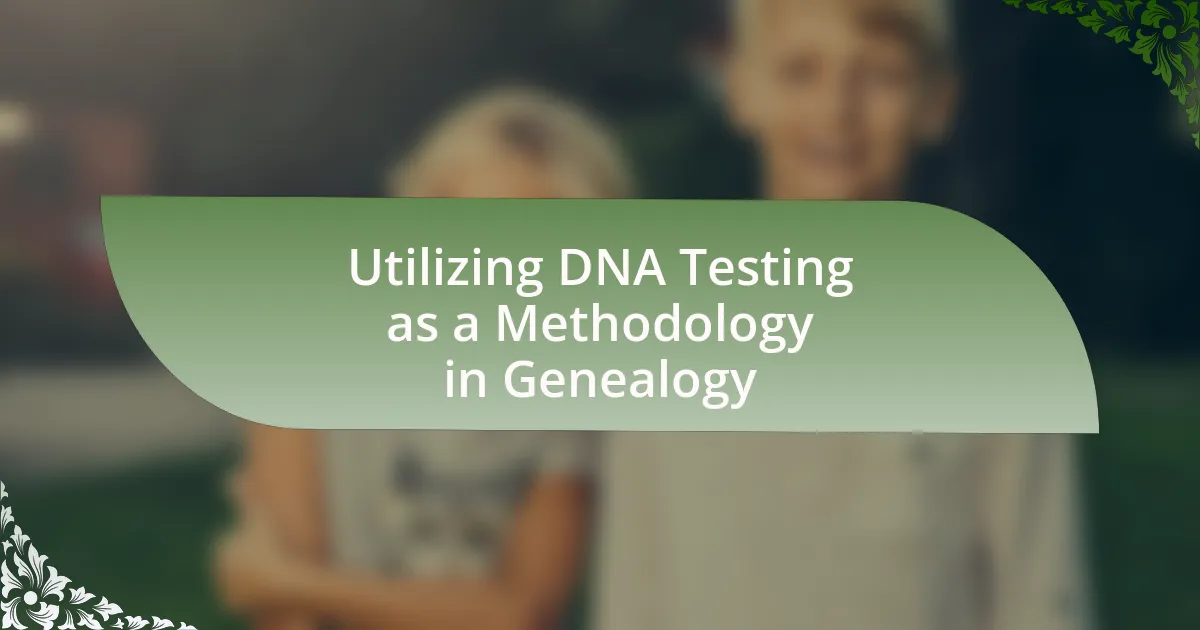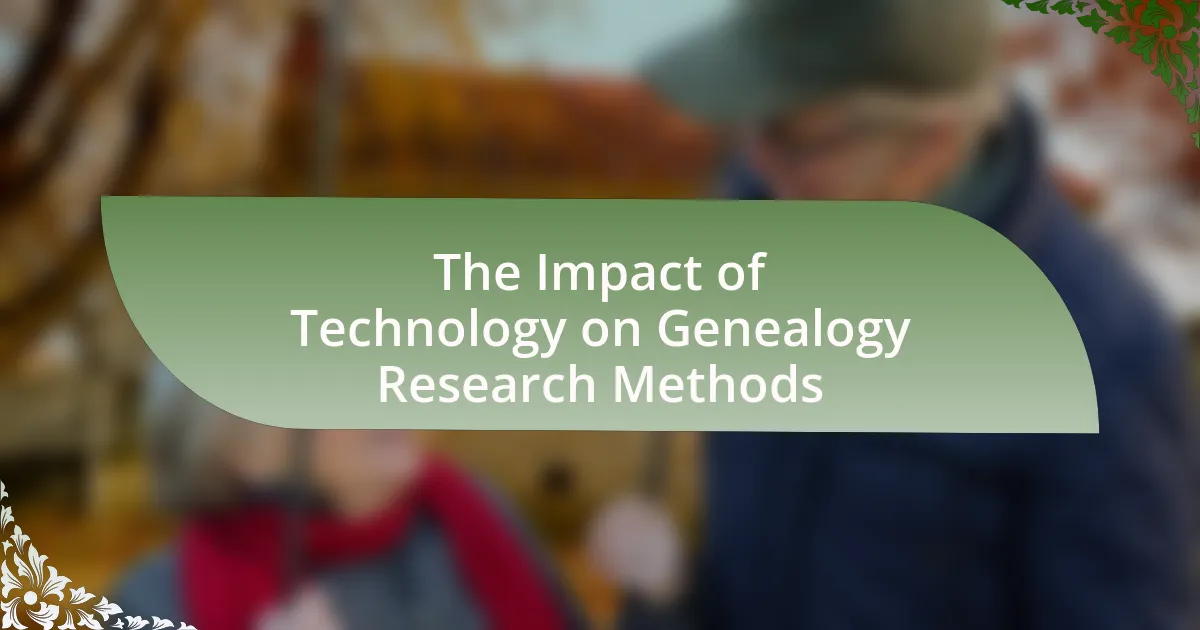The article examines the significant role of oral histories in genealogical studies, highlighting how personal narratives and firsthand accounts enhance family histories. It discusses the types of information gathered from oral histories, their contributions to understanding family lineage, and their importance in preserving cultural heritage. The article also addresses methods for effectively collecting oral histories, the challenges associated with their use, and best practices for integrating these narratives into genealogical research. Additionally, it emphasizes the ethical considerations and implications of sharing personal stories, ensuring a comprehensive understanding of the value of oral histories in genealogy.
What is the role of oral histories in genealogical studies?
Oral histories play a crucial role in genealogical studies by providing personal narratives and firsthand accounts that enrich family histories. These narratives often include details about ancestors’ lives, cultural practices, and historical events that may not be documented in written records. For instance, oral histories can reveal family traditions, migration stories, and social contexts that are vital for understanding lineage and heritage. Additionally, they can help fill gaps in official records, especially for marginalized communities where documentation may be sparse. This qualitative data enhances the accuracy and depth of genealogical research, making oral histories an invaluable resource for family historians.
How do oral histories contribute to understanding family lineage?
Oral histories significantly contribute to understanding family lineage by preserving personal narratives and ancestral knowledge that may not be documented elsewhere. These narratives often include details about family relationships, migration patterns, and cultural traditions, which are crucial for constructing a comprehensive family tree. For instance, oral histories can reveal connections between generations that official records might overlook, such as informal adoptions or familial ties that were not legally recognized. Additionally, studies have shown that oral traditions can provide context to historical events affecting families, enriching genealogical research with emotional and cultural dimensions that enhance the understanding of lineage.
What types of information can be gathered from oral histories?
Oral histories can gather personal narratives, cultural traditions, and historical events from individuals. These accounts provide insights into family lineage, community practices, and significant life experiences, often revealing details that are not documented in written records. For example, oral histories can include stories about migration patterns, social customs, and familial relationships, which are crucial for understanding genealogical contexts. Such information enriches genealogical studies by adding depth and personal perspectives to historical data.
How do oral histories complement traditional genealogical research?
Oral histories complement traditional genealogical research by providing personal narratives and context that are often absent from official records. While traditional genealogical research relies on documents such as birth certificates, marriage licenses, and census data, oral histories capture family stories, cultural practices, and individual experiences that enrich the understanding of lineage. For instance, oral histories can reveal relationships, migration patterns, and historical events that shaped a family’s identity, which may not be documented in written sources. This combination of personal accounts and official records creates a more comprehensive picture of ancestry, allowing researchers to fill in gaps and correct inaccuracies in traditional genealogical data.
Why are oral histories important in preserving cultural heritage?
Oral histories are crucial for preserving cultural heritage because they capture personal narratives and collective memories that written records often overlook. These narratives provide insights into traditions, values, and experiences that shape a community’s identity. For instance, oral histories can reveal unique cultural practices and historical events from the perspectives of individuals who lived through them, thus enriching the understanding of a culture’s evolution. Research by the Smithsonian Institution highlights that oral traditions are vital for transmitting knowledge across generations, ensuring that cultural practices remain alive and relevant.
How do oral histories reflect the experiences of different communities?
Oral histories reflect the experiences of different communities by capturing personal narratives that convey cultural values, traditions, and historical events unique to each group. These narratives provide insight into the lived experiences of individuals, illustrating how social, economic, and political factors shape community identities. For example, oral histories from Indigenous communities often highlight their connection to the land and the impact of colonization, while immigrant narratives may focus on the challenges of assimilation and cultural preservation. Research conducted by the Oral History Association emphasizes that these accounts serve as primary sources, enriching our understanding of diverse perspectives and fostering empathy across different cultural backgrounds.
What role do oral histories play in identity formation?
Oral histories play a crucial role in identity formation by preserving personal and communal narratives that shape individual and collective identities. These narratives provide context and continuity, allowing individuals to connect with their heritage and understand their place within a larger historical framework. Research indicates that oral histories contribute to identity by fostering a sense of belonging and cultural pride, as they often highlight shared experiences and values within a community. For example, studies have shown that communities that actively engage in oral history projects report stronger ties to their cultural identity and history, reinforcing the importance of these narratives in shaping who they are.
How can oral histories be effectively collected for genealogical studies?
Oral histories can be effectively collected for genealogical studies by employing structured interviews, utilizing recording technology, and ensuring a comfortable environment for the interviewee. Structured interviews guide the conversation, allowing for specific questions that elicit detailed responses about family history. Recording technology, such as audio or video devices, captures the nuances of the interview, preserving the interviewee’s voice and expressions, which are vital for context. Creating a comfortable environment encourages openness, leading to richer narratives. Research indicates that personal storytelling enhances memory recall, making it more likely that interviewees will share significant details about their ancestry.
What methods are best for conducting oral history interviews?
The best methods for conducting oral history interviews include preparing open-ended questions, establishing rapport with the interviewee, and using recording equipment effectively. Open-ended questions encourage detailed responses, allowing interviewees to share their experiences and perspectives fully. Establishing rapport is crucial as it creates a comfortable environment, leading to more candid and insightful narratives. Effective use of recording equipment ensures that the interviews are captured accurately, preserving the nuances of the conversation for future analysis. These methods are supported by best practices in oral history research, which emphasize the importance of creating a respectful and engaging interview atmosphere to elicit rich, meaningful stories.
What questions should be asked during an oral history interview?
During an oral history interview, questions should focus on personal experiences, family history, and significant life events. Specific questions may include inquiries about the interviewee’s childhood, family traditions, migration stories, and pivotal moments that shaped their identity. For example, asking about the interviewee’s earliest memories can elicit rich details about their upbringing, while questions about family members can reveal connections and lineage important for genealogical studies. These questions are essential as they help document individual narratives that contribute to a broader understanding of historical contexts and familial ties.
How can interviewers create a comfortable environment for sharing?
Interviewers can create a comfortable environment for sharing by establishing rapport and trust with participants. This can be achieved through active listening, maintaining a non-judgmental attitude, and ensuring confidentiality. Research indicates that when interviewers demonstrate empathy and respect, participants are more likely to open up and share personal stories, which is crucial in oral histories for genealogical studies. A study published in the Journal of Family History highlights that participants felt more at ease when interviewers used open-ended questions and provided positive reinforcement, leading to richer and more detailed narratives.
What tools and technologies can enhance oral history collection?
Digital recording devices, transcription software, and cloud storage solutions can significantly enhance oral history collection. Digital recording devices, such as handheld recorders or smartphones, ensure high-quality audio capture, which is essential for preserving the nuances of spoken narratives. Transcription software, like Otter.ai or Rev, facilitates the conversion of audio recordings into text, making it easier to analyze and share the collected stories. Cloud storage solutions, such as Google Drive or Dropbox, provide secure and accessible storage for both audio files and transcripts, allowing researchers to organize and retrieve oral histories efficiently. These tools collectively improve the accuracy, accessibility, and preservation of oral histories, which are vital for genealogical studies.
How can audio and video recordings improve the quality of oral histories?
Audio and video recordings enhance the quality of oral histories by capturing the nuances of speech, emotion, and context that written transcripts cannot convey. These recordings preserve the speaker’s tone, inflection, and body language, which are critical for understanding the depth of their experiences. Research indicates that visual and auditory elements significantly enrich the storytelling process, making it more engaging and authentic. For instance, a study published in the Journal of Oral History found that participants rated audio-visual oral histories as more impactful and memorable compared to text-only versions, highlighting the importance of sensory engagement in preserving personal narratives.
What software is available for transcribing oral histories?
Software available for transcribing oral histories includes Otter.ai, Rev, Trint, and Descript. Otter.ai offers real-time transcription and collaboration features, making it suitable for interviews. Rev provides professional transcription services with high accuracy, while Trint combines automated transcription with editing tools for ease of use. Descript allows users to edit audio and video alongside text, facilitating a seamless transcription process. These tools enhance the efficiency and accuracy of transcribing oral histories, which is crucial for genealogical studies.
What challenges are associated with using oral histories in genealogical studies?
Using oral histories in genealogical studies presents challenges such as reliability, memory distortion, and subjectivity. Oral histories can be influenced by the interviewee’s personal biases and recollections, leading to inaccuracies in the information provided. Research indicates that memory can fade or change over time, which may result in conflicting accounts of events or family lineage. Additionally, the context in which the oral history is recorded, including the interviewer’s influence and the setting, can affect the authenticity of the narrative. These factors complicate the verification of genealogical data derived from oral histories, making it essential for researchers to corroborate these accounts with documented evidence whenever possible.
How can the reliability of oral histories be assessed?
The reliability of oral histories can be assessed through critical evaluation of the source, context, and corroboration with other evidence. Evaluating the source involves examining the credibility of the narrator, their proximity to the events described, and their potential biases. Contextual analysis includes understanding the circumstances under which the oral history was recorded, such as the time period and social environment. Corroboration with written records, artifacts, or other oral accounts strengthens the reliability of the information. Research indicates that oral histories can provide valuable insights when assessed rigorously, as demonstrated in studies like “Oral History and the Study of the Past” by Paul Thompson, which emphasizes the importance of cross-referencing oral accounts with historical data.
What factors can affect the accuracy of oral histories?
The accuracy of oral histories can be affected by several factors, including memory distortion, the influence of social and cultural contexts, and the passage of time. Memory distortion occurs as individuals may unintentionally alter details of their recollections, influenced by personal biases or external information. Social and cultural contexts can shape how stories are told, as narrators may emphasize certain aspects to align with community values or expectations. Additionally, the passage of time can lead to the fading of memories or the blending of different events, further complicating the reliability of oral accounts. These factors collectively contribute to the challenges in verifying the accuracy of oral histories in genealogical studies.
How can biases in oral histories be identified and addressed?
Biases in oral histories can be identified through critical analysis of the narratives, including examining the speaker’s background, context, and the specific language used. Researchers can address these biases by cross-referencing oral accounts with documented evidence, employing triangulation methods, and encouraging diverse perspectives to create a more balanced understanding. For instance, a study by Portelli (1991) highlights how personal experiences shape recollections, emphasizing the need for contextual awareness in oral history research.
What ethical considerations should be taken into account?
Ethical considerations in the context of oral histories in genealogical studies include informed consent, confidentiality, and the potential for emotional impact on participants. Informed consent ensures that individuals understand the purpose of the oral history project and agree to participate voluntarily. Confidentiality protects sensitive information shared by participants, which is crucial for maintaining trust. Additionally, researchers must be aware of the emotional implications of discussing personal and familial histories, as these narratives can evoke strong feelings. These considerations are supported by ethical guidelines from organizations such as the American Historical Association, which emphasizes the importance of respecting participants’ rights and well-being in historical research.
How can consent be obtained from interview subjects?
Consent can be obtained from interview subjects by clearly explaining the purpose of the interview, how the information will be used, and ensuring that subjects understand their rights. This process typically involves providing a consent form that outlines these details, allowing subjects to ask questions and ensuring they voluntarily agree to participate. Research indicates that informed consent is crucial in ethical research practices, as it respects the autonomy of participants and fosters trust between the interviewer and the subject.
What are the implications of sharing personal stories publicly?
Sharing personal stories publicly can lead to both positive and negative implications. On the positive side, sharing personal narratives can foster community connections, enhance understanding of diverse experiences, and contribute to collective memory, which is essential in genealogical studies. For instance, oral histories can provide unique insights into family histories that are not captured in official records, enriching genealogical research. Conversely, the negative implications include potential privacy violations, emotional distress for the storyteller, and the risk of misinterpretation or misuse of shared information. Research indicates that individuals may experience anxiety or regret after sharing personal stories, particularly if they feel vulnerable or exposed. Therefore, while sharing personal stories can be beneficial for community and genealogical understanding, it is crucial to consider the potential emotional and privacy-related consequences.
What best practices should be followed when utilizing oral histories in genealogy?
Best practices for utilizing oral histories in genealogy include thorough preparation, effective interviewing techniques, and proper documentation. Preparation involves researching the subject’s background and formulating open-ended questions to encourage detailed responses. Effective interviewing techniques, such as active listening and creating a comfortable environment, enhance the quality of the information gathered. Proper documentation entails recording interviews accurately, transcribing them, and noting the context of the conversation, including the date, location, and any relevant background information about the interviewee. These practices ensure the reliability and richness of oral histories, which can significantly contribute to genealogical research by providing personal narratives that complement traditional records.
How can oral histories be archived for future generations?
Oral histories can be archived for future generations by recording them in digital formats and storing them in accessible databases. This process involves using audio or video recording devices to capture the narratives of individuals, ensuring high-quality sound and image for clarity. Once recorded, these oral histories should be transcribed and indexed to facilitate easy retrieval and research. Additionally, archiving organizations, such as the Library of Congress, provide guidelines for preserving these recordings, emphasizing the importance of metadata to contextualize the stories. By utilizing cloud storage and digital preservation techniques, oral histories can be safeguarded against deterioration and made available to researchers and the public, thus ensuring their longevity and relevance in genealogical studies.
What strategies can be employed to integrate oral histories into genealogical research?
To integrate oral histories into genealogical research, researchers can employ strategies such as conducting structured interviews, utilizing audio and video recordings, and cross-referencing oral accounts with documented records. Structured interviews allow for the collection of specific information about family lineage, while audio and video recordings preserve the nuances of personal narratives, enhancing the richness of the data. Cross-referencing oral histories with census records, birth and death certificates, and other archival materials ensures accuracy and provides a more comprehensive understanding of family histories. These methods have been shown to enhance genealogical research by filling gaps in written records and providing context that may not be captured in traditional documentation.




